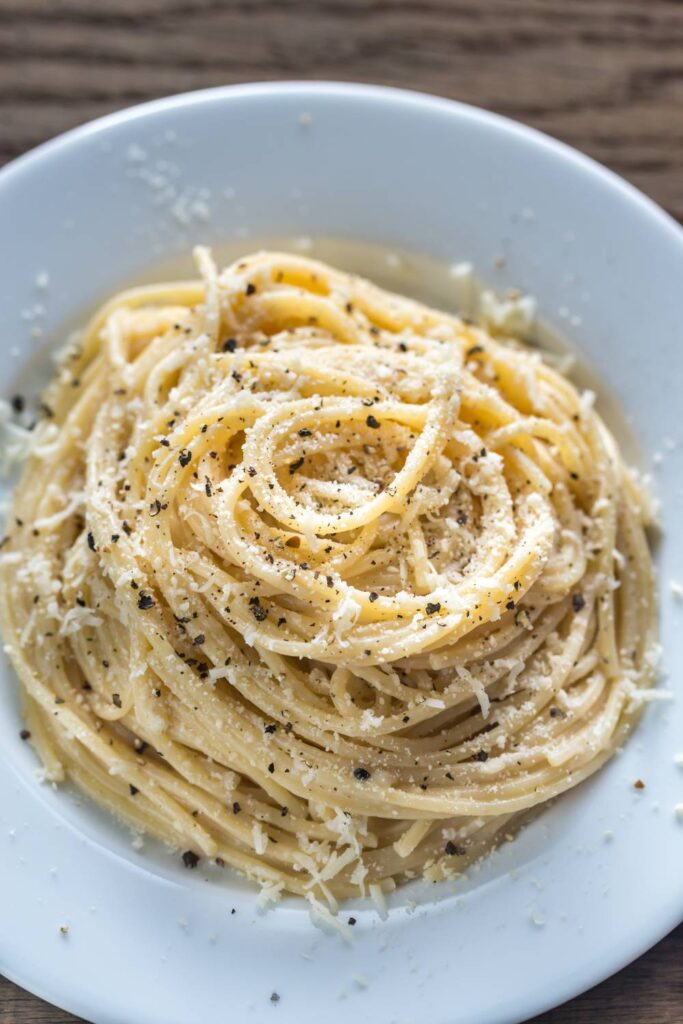From the eternal city of Rome comes one of the most iconic dishes in Italian cuisine: Cacio e Pepe. Simple yet sophisticated, it perfectly embodies the elegance of doing more with less. Translating to “cheese and pepper,” this dish uses just a handful of ingredients—pasta, Pecorino Romano, and black pepper—but mastering it requires more than following a recipe.
While its roots trace back to the Roman Empire, this classic dish experienced a global resurgence in the 2010s, becoming a staple on menus far beyond Italy. From Anthony Bourdain’s raves on No Reservations to its rise in fine dining establishments, Cacio e Pepe has captured the hearts of food lovers worldwide. But the true magic of this dish lies in bringing it to life in your kitchen.
If you’ve ever struggled with clumpy cheese or runny sauce, worry no more. We’ve got the tips and tricks to elevate your Cacio e Pepe from good to unforgettable. Ready to cook? Visit our recipe here and let’s dive in.
1. Choosing the Perfect Pasta Shape
Cacio e Pepe is traditionally made with tonnarelli, a thick, square-shaped pasta similar to spaghetti but with a denser texture. Its rough surface helps the sauce cling beautifully to each strand. If tonnarelli isn’t available, try:
| Alternative Pasta Options | Why They Work |
|---|---|
| Bucatini | Hollow center traps sauce for a richer bite. |
| Spaghetti | A readily available classic with a smooth finish. |
| Rigatoni or Fusilli | Short shapes with grooves to catch every drop. |
No matter the shape, prioritize bronze-cut pasta, as its textured surface helps the sauce adhere better than smooth, machine-cut pasta.
2. Invest in Quality Cheese
The soul of Cacio e Pepe lies in Pecorino Romano, a sharp, salty cheese made from sheep’s milk. Its bold flavor defines the dish and sets it apart from other pasta recipes. For the best results:
- Use authentic Pecorino Romano from Lazio. It’s tangier and saltier than substitutes.
- For added creaminess, you can blend Pecorino Romano with a small amount of Parmigiano Reggiano.
| Cheese Tips | Why It Matters |
|---|---|
| Grate finely using a microplane or zester. | Finer cheese melts evenly, preventing clumping. |
| Avoid pre-grated cheese. | Additives prevent proper emulsification. |

3. The Power of Freshly Cracked Pepper
The pepper in Cacio e Pepe isn’t just a seasoning—it’s a star ingredient. Pre-ground pepper won’t deliver the bold, spicy kick that defines the dish. Instead:
- Toast whole peppercorns in a dry skillet until aromatic.
- Grind them fresh just before use.
For an elevated twist, consider drizzling in a touch of pepper-infused olive oil for extra depth.
4. Mastering the Heat
One of the most common mistakes in making Cacio e Pepe is overheating the cheese, which causes it to clump. Here’s the golden rule:
- Turn off the heat before adding the cheese.
Residual heat from the pasta and pan is sufficient to melt the cheese into a silky sauce.
Why This Works
Pecorino Romano has a low melting point. Too much direct heat causes it to separate, resulting in a grainy texture. By keeping the heat off, you allow the cheese to emulsify gently with the starchy pasta water.

5. The Magic of Pasta Water
Pasta water is the unsung hero of Cacio e Pepe. Its starch content is what binds the cheese and pepper into a creamy sauce. Here’s how to use it effectively:
- Save at least 1½ cups of pasta water before draining.
- Add the water gradually, tossing vigorously to create an emulsion.
| Common Mistakes | Why It Happens | How to Fix It |
|---|---|---|
| Sauce too watery. | Too much water added at once. | Add water a little at a time while tossing. |
| Sauce clumpy or grainy. | Cheese overheated or pasta not hot enough. | Use residual heat and stir vigorously. |
| Sauce doesn’t coat the pasta. | Not enough starch in the water. | Always use pasta water, not plain water. |
6. Bringing It All Together
Cacio e Pepe is more than just a dish—it’s an art form that teaches the value of restraint and technique. With just three main ingredients, every detail matters. Here’s why it’s worth perfecting:
- Quick and Versatile: Ready in under 30 minutes, it’s perfect for weeknights or special occasions.
- A Showcase of Ingredients: High-quality cheese and pepper transform a humble dish into a gourmet experience.
- A Testament to Technique: Mastering Cacio e Pepe teaches skills like emulsification and heat control, which are essential in the kitchen.
Pair it with a crisp white wine like Verdicchio or a light red such as Chianti for the ultimate Roman dining experience.
Ready to Master Cacio e Pepe?
Now that you know the secrets, it’s time to bring this iconic dish to life. Ready to cook? Visit our recipe here and start creating your own perfect bowl of authentic Cacio e Pepe.









